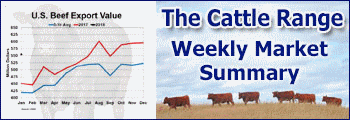January ‘World Agricultural Supply and Demand Estimates’
LIVESTOCK & POULTRY:
Red meat and poultry production for 2024 is lowered from last month due to lower beef, pork, broiler, and turkey production in the fourth quarter. Changes in the estimates reflect November production data and preliminary estimates of slaughter numbers and weights for December. For 2025, the beef forecast is raised on an increase in steer and heifer slaughter due to higher placements expected during the fourth quarter of 2024, as well as higher dressed weights. USDA’s Cattle report, which will be released January 31, will provide an indication of the number of cattle available for placement during 2025 as well as producer intentions for retaining heifers for addition to the breeding herd. Pork production is raised reflecting pig crop and farrowings data for the second half of 2024 and the first half of 2025 published in the
December Quarterly Hogs and Pigs report. Broiler production is lowered based on recent slaughter data indicating lower-than-previously expected WASDE-656-4 weights. Turkey production is lowered for the first half of 2025 based on recent hatchery data and HPAI-related culling through early January.
Beef import and export estimates for 2024 are raised on recent trade data. For 2025, beef imports are raised largely on continued strong shipments of beef from Oceania and South America. The 2025 beef export forecast is unchanged. Pork exports for 2024 are lowered based on recent trade data, but exports for 2025 are unchanged. Broiler exports in 2024 are lowered on recent trade data. Broiler exports for 2025 are also lowered on lower available supplies and strong price competition. Turkey exports are lowered for 2024 and 2025 on the recent trade data and lower domestic supplies. Price estimates for 2024 are adjusted to reflect December data.
For 2025, cattle prices are raised on recent prices and continued strong demand for cattle and beef. Hog prices are raised in 2025 supported by higher cattle and poultry prices. Broiler prices in 2025 are projected higher on lowered supplies and as stronger prices in late 2024 are expected to carry over into 2025. Turkey prices for 2025 are lowered with lower prices in late 2024 carrying over into 2025.
Corn:
This month’s 2024/25 U.S. corn outlook is for lower production, feed and residual use, exports, and ending stocks. Corn production is estimated at 14.9 billion bushels, down 276 million as a 3.8-bushel per acre cut in yield to 179.3 bushels is partially offset by a 0.2-million acre increase in harvested area. Total corn use is down 75 million bushels to 15.1 billion. Feed and residual use is reduced 50 million bushels to 5.8 billion, based on indicated disappearance during the September-November quarter as reflected by the Grain Stocks report.
Exports are cut 25 million bushels to 2.5 billion reflecting lower supplies. With supply falling more than use, corn stocks are lowered 198 million bushels. The season-average corn price received by producers is raised 15 cents to $4.25 per bushel.
Global coarse grain production for 2024/25 is forecast down 4.8 million tons to 1.494 billion. This month’s foreign coarse grain outlook is for greater production, reduced trade, and higher ending stocks.
WHEAT:
The outlook for 2024/25 U.S. wheat this month is for slightly larger supplies and domestic use, unchanged exports, and marginally higher ending stocks. Supplies are raised on higher imports, increased 5 million bushels to 130 million, all on Hard Red Spring. Feed and residual use is unchanged at 120 million bushels but there are offsetting by-class changes based on the NASS Grain Stocks report. Seed use is increased 2 million bushels to 64 million, based on the NASS Winter Wheat and Canola Seedings report.
Exports are unchanged at 850 million bushels but there are offsetting by-class changes. Projected 2024/25 ending stocks are raised 3 million bushels to 798 million, up 15 percent from last year. The season-average farm price is reduced $0.05 per bushel to $5.55 on NASS prices reported to date and expectations for futures and cash prices for the remainder of the marketing year.
The global wheat outlook for 2024/25 is for slightly larger supplies, lower consumption, reduced trade, and higher ending stocks.











